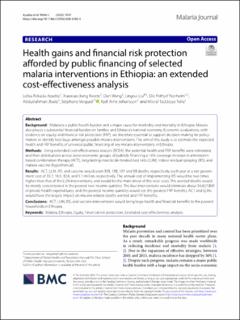| dc.description.abstract | Background
Malaria is a public health burden and a major cause for morbidity and mortality in Ethiopia. Malaria also places a substantial financial burden on families and Ethiopia’s national economy. Economic evaluations, with evidence on equity and financial risk protection (FRP), are therefore essential to support decision-making for policymakers to identify best buys amongst possible malaria interventions. The aim of this study is to estimate the expected health and FRP benefits of universal public financing of key malaria interventions in Ethiopia.
Methods
Using extended cost-effectiveness analysis (ECEA), the potential health and FRP benefits were estimated, and their distributions across socio-economic groups, of publicly financing a 10% coverage increase in artemisinin-based combination therapy (ACT), long-lasting insecticide-treated bed nets (LLIN), indoor residual spraying (IRS), and malaria vaccine (hypothetical).
Results
ACT, LLIN, IRS, and vaccine would avert 358, 188, 107 and 38 deaths, respectively, each year at a net government cost of USD 5.7, 16.5, 32.6, and 5.1 million, respectively. The annual cost of implementing IRS would be two times higher than that of the LLIN interventions, and would be the main driver of the total costs. The averted deaths would be mainly concentrated in the poorest two income quintiles. The four interventions would eliminate about USD 4,627,800 of private health expenditures, and the poorest income quintiles would see the greatest FRP benefits. ACT and LLINs would have the largest impact on malaria-related deaths averted and FRP benefits.
Conclusions
ACT, LLIN, IRS, and vaccine interventions would bring large health and financial benefits to the poorest households in Ethiopia. | en_US |

